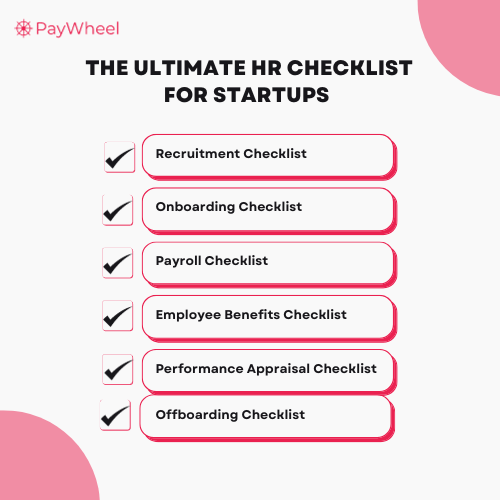HR professionals play a pivotal role in crafting and implementing employee policies while overseeing business operations. They establish the basic rules and procedures of the workplace while providing employees with clear guidance on how the organization operates. HR professionals are often burdened with many tasks, and it can be possible that they may inadvertently overlook some details.
In such circumstances, an HR checklist can be a game-changer. An HR checklist, specifically designed for the Indian context, is a valuable tool to enhance efficiency and ensure comprehensive task management. So, let’s find out what exactly is an HR checklist and how it is important for startup businesses?.
Table of Contents
What is HR Checklist?
An HR checklist is a document of reference that serves as a checklist of important tasks that must be completed. It also functions as a guiding tool for HR professionals to navigate through their responsibilities. A well-structured HR checklist is especially important for startups since it helps with better planning and strategic execution of responsibilities based on their priorities.
Why Do We Need an HR Checklist for Startups?
Startups operate in a fast-paced environment characterized by rapid growth and transformation. An HR checklist helps to ensure that companies comply with legal and regulatory standards, thereby aiding in risk mitigation. It helps to establish a foundational framework for recruitment, onboarding, and employee management. It also aids startups in enhancing their employee experience and business operations and in designing scalable HR processes that can adapt to the evolving needs of the business..
Top 10 Components of HR Checklist for Startups
- Recruitment
- Onboarding
- Training and Development
- Employee Information & Records
- Legal Compliance
- Performance Management
- Payroll and Benefits
- Employee well-being
- Employee engagement
- Offboarding & Exit Process
Top 6 HR Checklist for Startups
A payroll system is a software that is designed to automate the process of salary calculations and payroll management. It helps to track employee time and attendance, tax calculations & deductions, generate payslips and more. Unlike manual payroll which can be time-consuming and prone to errors, automated payroll systems leverage technology, reducing the likelihood of mistakes and saving valuable time for both employers and employees.
Recruitment Checklist
- Clear job description
- Job boards, internal database & employee referrals
- Application Screening
- Phone screening
- Skill Assessment
- Candidate Interview
- Offer Letter
Onboarding Checklist
- Document Collection
- Document Verification
- Appointment letter
- Background Verification
- Office equipment and resources
- Internal announcement
- Introduction to the team
- Onboarding induction & training
- Account / ID creation
- PF enrollment/transfer
- Insurance enrollment
- Employee connect calls
Payroll Checklist
- Salary structure
- Leave and attendance
- Statutory reports
- Employee Bonus
- Insurance
- Tax calculations- investment declaration & proof submission
- Reimbursements
- Payslips
- Form 16
Employee Benefits Checklist
- EPF, ESIC / Retiral benefits
- Stock options
- Paid time-off
- Gift vouchers
- Gratuity
- NPS
- Meal card
- Transportation
- Loans
- Training & Developmemt
- Annual Leaves
- Maternity / Paternity leaves
Performance Appraisal Checklist
- Objective setting & Accomplishments
- Probation
- Rewards & Recognition
- Succession Planning
- Appraisal
Offboarding Checklist
- Resignation
- Notice Period
- Transition- Knowledge Transfer
- Exit interview
- Severance pay, if any
- Relieving letter /experience letter
- Payroll exit
- F&F settlement

FAQs
What is the purpose of HR checklist?
HR checklists help to create a structure and outline key HR processes such as recruitment, onboarding, and offboarding. It can also help in maintaining legal compliance and documentation. Therefore, an HR checklist can help support every aspect of employee lifecycle management.
How often should an HR checklist be reviewed and updated?
HR checklists must be reviewed and updated every three months, as there can be potential changes in labor laws, compliance regulations, business goals and recruitment strategies. Incorporating the latest trends in hiring and employee engagement can also significantly improve the performance of employees.
What are the key components of an effective onboarding process?
An effective onboarding process includes orientation sessions that inform employees about the organizational goals and values. This involves offering new hires with essential skills training. And resources and mentors to help them understand their job role and tasks.
How can startups ensure legal compliance in HR practices?
Ensuring legal compliance is non-negotiable for any company regardless of its size. Staying updated about the changes in labor laws and regulations, creating procedures to address any legal concerns and regular audits are some of the ways in which startups can ensure legal compliance.
Why is employee engagement important for startups?
Employee engagement is one of the most crucial aspects for startups, as it directly influences productivity, employee satisfaction, and retention. It can also contribute to building a healthy work environment and strong client relationships, thereby directly impacting the profitability and organizational success of startups in the long run.
What role does technology play in modern HR practices for startups?
Technology has had a significant impact on HR practices by simplifying HR operations, enhancing efficiency, and offering tools for recruitment, onboarding, performance management, and more. HRM software like PayWheel helps in managing time and attendance, ensuring legal compliance, and streamlining payroll management from employee documentation to exit interviews and offboarding.
How can startups promote diversity, equity, and inclusion in the workplace?
Startups can support and encourage diversity, equality, and inclusion by promoting diversity in hiring and establishing an inclusive workplace. Providing awareness sessions can also help promote diversity and eliminate preconceived notions in the workplace.
Conclusion
In short, an HR checklist can be used as a tool to address and navigate the challenges of human capital management. Integrating an HRM software such as PayWheel can help support HR professionals by automating routine tasks and organizing employee information. PayWheel’s various features, such as payroll management, statutory compliance, and attendance management, can provide data-driven insights and help companies adapt to their evolving business requirements.